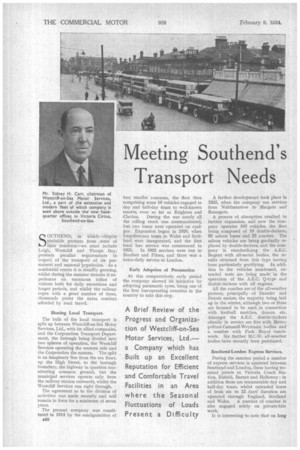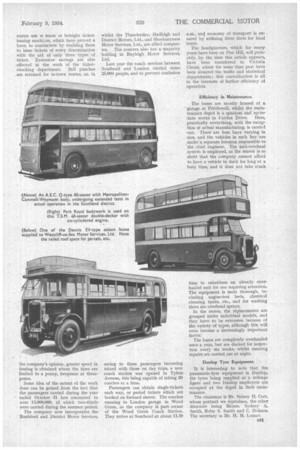Meeting Southend's Transport Needs
Page 118

Page 119

If you've noticed an error in this article please click here to report it so we can fix it.
SOUTHEND, in Which—despite probable protests from some of their residents—we Must include Leigh, Westclitf and Thorpe Bay, preSents peculiar requirements in respect of the transport of its permanent and seasonal 'population. As a residential centre it is steadily growing, whilst during the summer months it experiences an enormous influx of visitors both for daily excursions and longer periods, and whilst the railway copes with a great number of these,
• thousands prefer the extra comfort afforded by road travel.
Sharing Local Transport.
The hulk of the local transport is split up between Westcliff-on-Sea Motor Services, Ltd., with its allied companies, and the Corporation Transport Department, the borough being divided into two spheres of operation, the Westcliff Services operating the western side and the Corporation the eastern. The split is an imaginary line from the sea front, up the High Street, to the borough boundary, the highway in question constituting common ground, but the municipal services operate only from the railway station outwards, whilst the Westcliff Services run right through. The agreement as to the division of activities was made recently and will remain in force for a minimum of seven years.
The present company was constituted in 1914 by the amalgamation of E60
two smaller concerns, the fleet then comprising some 10 vehicle engaged in day and half-day tours to well-known resorts, even so far as Brighton and Clacton. During the war nearly all the rolling stock was commandeered, but two buses were operated on coalgasExpansion began in 1920, when long-distance tours to Wales and Scotland were inaugurated, and the first local bus service was commenced in 1921. In 1922 services were run to Benfleet and Pitsea, and there was a twice-daily service to London.
Early Adoption of Pneumatics.
At this comparatively early period the company showed its initiative by adopting pneumatic tyres, being one of the first bus-operating concerns in the countrY to take this step. A further development took place in 1925, when the company ran services from Walthamstow to Margate and Ramsgate.
A process of absorption resulted in further expansion, and now the &anpany operates 103 vehicles, the fleet being composed of 19 double-deckers, 62 saloon buses and 22 coaches. The saloon vehicles are being gradually replaced by double-deckers, and the company is standardizing the A.E.C. Regent with all-metal bodies, the results obtained from this type having been particularly gratifying. In addition to the vehicles mentioned, extended tests are being made' :in the operation of the A.E.C. Q-type and double-deckers with oil engines.
All the coaches are of 'the all-weather pattern, principally • of Daimler and Dennis makes, the majority being laid . up in the winter, although two or three are licensed to be used in connection with football matches, dances, etc. Amongst the A.E.C. double-deckers already in service are five with Metropolitan-Cammell:Wernann bodies and a number with Park Royal coachwork. Six further M.C.W. all-weather bodies have recently been purchased.
Southend-London Express Services.
During the summer period a number of express services is operated between Southend and London, these having terminal points at Victoria Coach Station, Enfield, Barnet and Holloway ; in addition there are innumerable day and half-day tours, whilst extended tours of from six to 12 days' duration are operated through England, Scotland and Wales. A number of coaches is also engaged solely on private-hire work.
It is interesting to note that on long
routes use is made or Setright ticketissuing machLes, which have proved a boon to conductors by enabling them to issue tickets of every denomination with the aid of only three types of ticket. Extensive savings are also effected in the work of the ticketchecking department. Bell punches are retained for in-town routes. as. in the company's opinion, greater speed in issuing is obtained where the fares are limited to a penny, twopence or threepence.
Some idea of the extent of the work done can be gained .from the fact that the passengers carried during the year ended October 31 last amounted to over 13,000,000, of which two-thirds were carried during the summer period.
The company now incorporates the Rochford and District Motor Services, whilst the Thundersley, Hadleigh and District Motors, Ltd., and Shocburyness Motor Services, Ltd., are allied companies. The concern also has a majority holding in Rayleigh Motor Services, Ltd.
Last year the coach services between Southend and London carried Some 25,000 people, and to prevent confusion
owing to these passengers becoming mixed with those on day trips, a new coach station was opened in Tylers Avenue, this being capable of taking 20 coaches at a time.
Passengers can obtain single-tickets each way, or period tickets which are booked on forward sheets. The coaches running to London garage in Wood Green, as the company is part owner of the Wood Green Coach Station. They arrive at Southend at about 11.30 an4 economy of transport is ensured by utilizing them there for local tours.
The headquarters, which for many years have been on Pier Hill, will probably, by the time this article appears, have been transferred to Victoria Circus, where for some time past have been situated the traffic and statistical departments ; this centralization is all in the interests of further efficiency of operation.
Efficiency in Maintenance.
The buses are mostly housed at a ' garage at Prittlewell, whilst the maintenance depot is a spacious and up-todate works in Fairfax Drive. Here, practically everything, with the exception of actual manufacturing, is carried out. There are four bays varying in size, and the vehicles in each bay are under a separate foreman responsible to the chief engineer. The unit-overhaul system is employed, as the season is so short that the company cannot 'afford to have a vehicle in dock for long at a busy time, and it does not take much time to substitute an already overhau:ed unit for one requiring attention. The equipment is most thorough, including engine-test beds, chemical cleaning tanks, etc., and for washing there are overhead sprays.
In the stores, the replacements are grouped under individual models, and they have to be extensive because of the variety of types, although this will soon become a decreasingly important factor.
The buses are completely overhauled once a year, hut are docked for inspec,. tion every six weeks, whilst running repairs are carried out at night.
Dunlop Tyre Equipment.
It is interesting to note that the pneumatic-tyre equipment is Dunlop, the tyres being supplied at a mileage figure and two Dunlop employees are occupied at the depot in their maintenance. "
The chairman is Mr. Sidney H. Carr, whose portrait we reproduce, the other directors being Messrs. Sydney A. Smith, Roby S. Smith and C. Holmes. The secretary is Mr. H. M. Lomax.




































































































































































